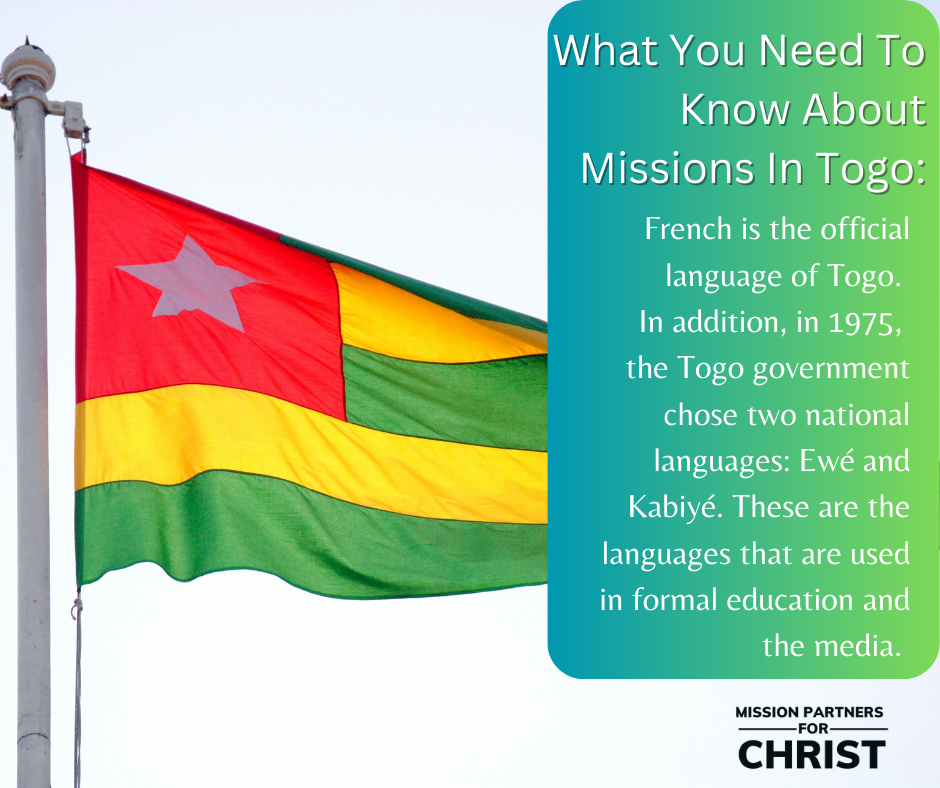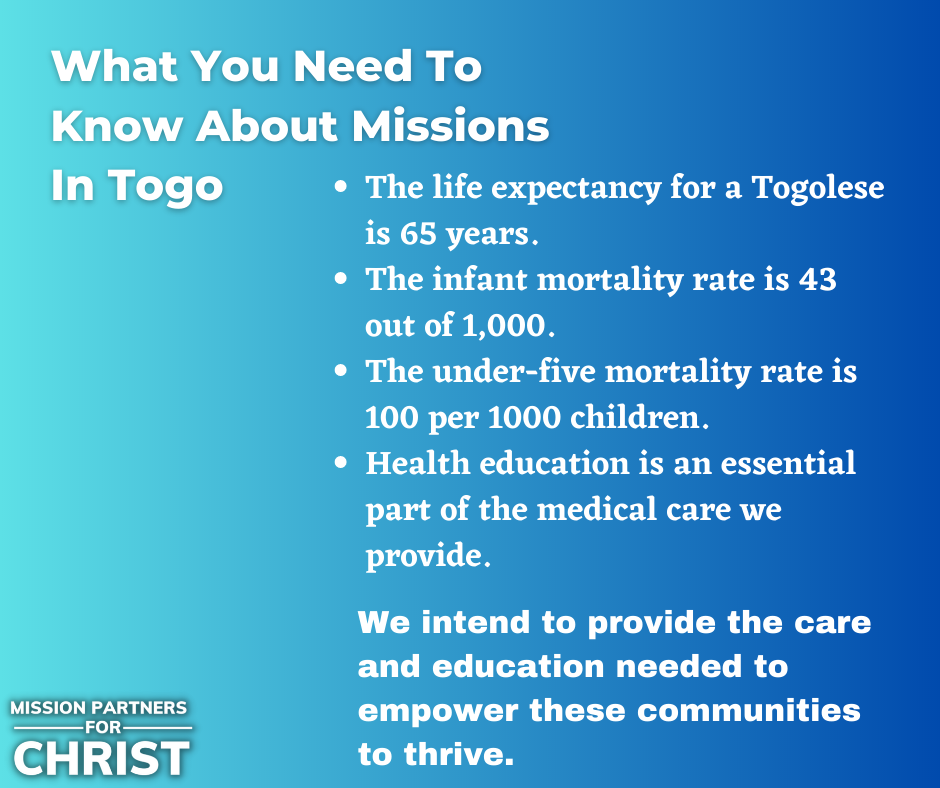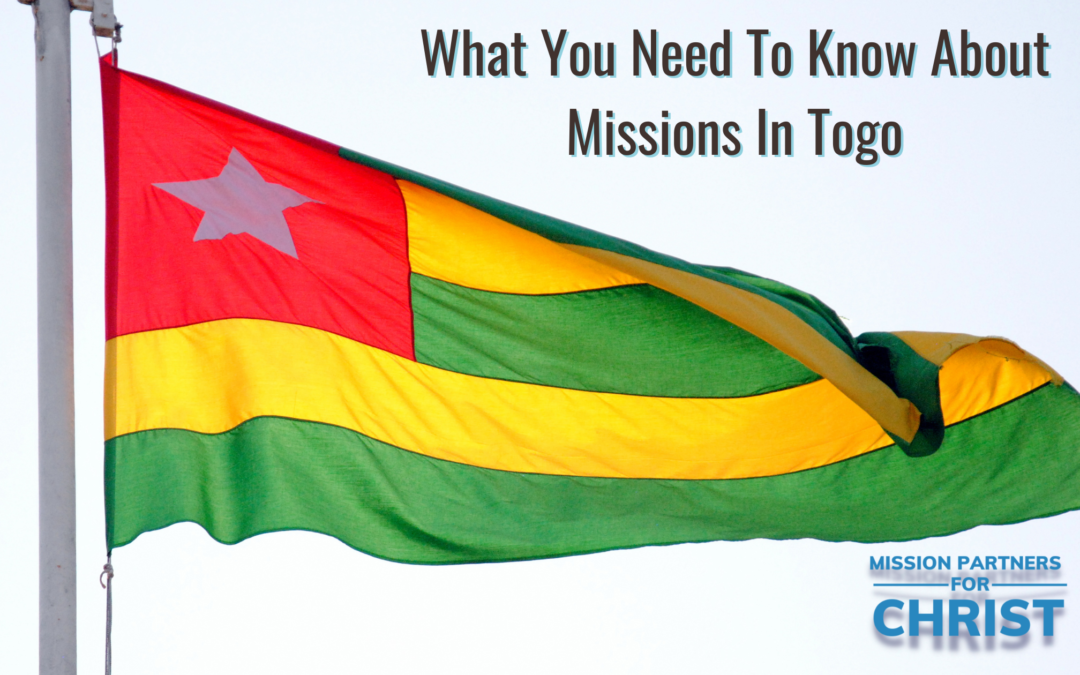In roughly three months, Mission Partners For Christ will be traveling to minister to a new community, both underserved and unreached with the gospel, to provide free medical care and health education.
“But where is Togo?” I hear you all asking. It’s a fair question as few of us here in the United States have heard about Togo. So now is a great time to introduce you to this beautiful land and its people.
Where Is Togo and What Is Her Story?
The Togolese Republic, otherwise known as Togo, is a small nation of nearly 9,000,000 people, and is bordered by Ghana on the west, Benin on the east, and Burkina Faso to the north.
Togo has a long history that stretches back to the 11th century. Many different people groups and tribes called the land home, such as the Ewé, Gun, and Mina tribes, who mostly settled in coastal areas.
Tragically, the region in which Togo is situated was a prime target for slave traders between the 16th and 18th centuries. So much so that it became colloquially known as “the slave coast.”
In 1884, King Mlappa III signed an agreement with Germany in which the land was declared a “protectorate” of the German people. This allowed Togo to enjoy its autonomy while also receiving the benefit of protection from Germany. In 1905, Togo became an official colony of Germany and was referred to as “Togoland.” The Togolese people were put to work and forced to cultivate cocoa, cotton, and coffee and pay taxes to their overseers.

In 1914, during the first world war, British and French forces invaded Togoland and defeated the Germans. As a result, Togoland was divided into French and British territories. Over the next few decades, power would change hands a few times for the French and the British Togolands. Ultimately, French Togoland gained autonomy within the French empire and became independent in 1960.
Who Are The People Who Call Togo Home?
While the immigrants make up a large part (30%) of Togo’s population, many indigenous tribes also call Togo home: Ewe (22.2% of the population), Kabre (13.4%), Wachi (10%), Mina (5.6%), Kotokoli (5.6%), Bimoba (5.2%), Losso (4%), Gurma (3.4%).
As a nation of incredible diversity, it likely comes as no surprise that the languages spoken in Togo are numerous: 44, to be exact! However, French is the official language of Togo. In addition, in 1975, the Togo government chose two national languages: Ewé and Kabiyé. These are the languages that are used in formal education and the media.
Since declaring independence in 1967, cultural aspects have been taking shape. You can find the national archives and the national library in Lomé. Also found in Lomé: The Palais de Lomé, which was once the home to colonial-era rulers but has since been turned into a museum of contemporary art.
What Is The Climate in Togo?
Togo is primarily a tropical climate that averages temperatures between the high 70s and 80s Fahrenheit. Although, in the mountains, you might find temperatures will fall as low as the 60s Fahrenheit.
Togo also has two major rainy seasons in the south: Mid-April-June and Mid-September-October. The north only has one rainy season: The end of June-September.
One of the reasons Mission Partners For Christ chose November for our travel dates is to avoid the rainy season. So much of our work (and our tourist adventures) is spent in the great outdoors. Avoiding the rainy season ensures a much better experience for all our wonderful volunteers.

What Do Togolese People Believe?
Just like the ethnicities of the Togolese people are quite diverse, so, too, are their belief systems.
33% of Togolese people hold to traditional belief systems. World Atlas describes these belief systems in this way:
World Atlas
The majority of Togo’s population follow their traditional ethnic religions and beliefs which vary widely across ethnic groups and regions in the country. Some examples include the cult of ancestors, fetishism, the forces of nature, etc. These beliefs usually share some common features such as belief in the existence of spirits, belief in magic, respect for the ancestors and the dead, belief in a supreme being, and the use of traditional medicines. The leaders of these religions or sects are often associated with magical powers and are regarded as the connection between the supernatural and the human world. Initiation ceremonies are usually held to welcome a girl or a boy into adulthood. Voodoo which involves the worship of the spirits and other practices associated with magic is also practiced here. Followers often enter into a trance-like state during voodoo ceremonies where they claim to communicate with the spirit world. Religious customs and taboos are maintained strictly. Even most Togoans who adhere to the major religions of the world engage in traditional religious practices. The dwellings in Togo usually have an altar for deity worship. Regular sacrifices are made to please the deities and ensure their protection.
The next most significant religious sector would be Roman Catholicism, which 27.8% of the population identifies with. After that, 13.7% of Togolese people identify as Muslim. 9.9% identify as independent/other Christian, while 9.5% identify as Protestant.
Why Are We Going To Togo?
The life expectancy for a Togolese is 65 years. The infant mortality rate is 43 out of 1,000. The under-five mortality rate is 100 per 1000 children. Health education is an essential part of the medical care we provide. Unfortunately, many people do not realize they have high blood pressure, and if they do, they do not know how to manage it properly.
We intend to provide the care and education needed to empower these communities to thrive.
As always, the gospel is at the heart of our work, and we go into these communities to ensure that people will hear the good news of Jesus Christ and come to know Him as their Savior.
We hope that you will join us in Togo. Applications will close soon, on August 18, so don’t wait! And if you need some ideas for fundraising, here’s a recent post you can check out!
Remember: Medical and dental students may qualify for a scholarship that goes towards the total cost of one of our medical mission trips!

—
Sources:
Wikipedia, World Meters, Brittanica,


